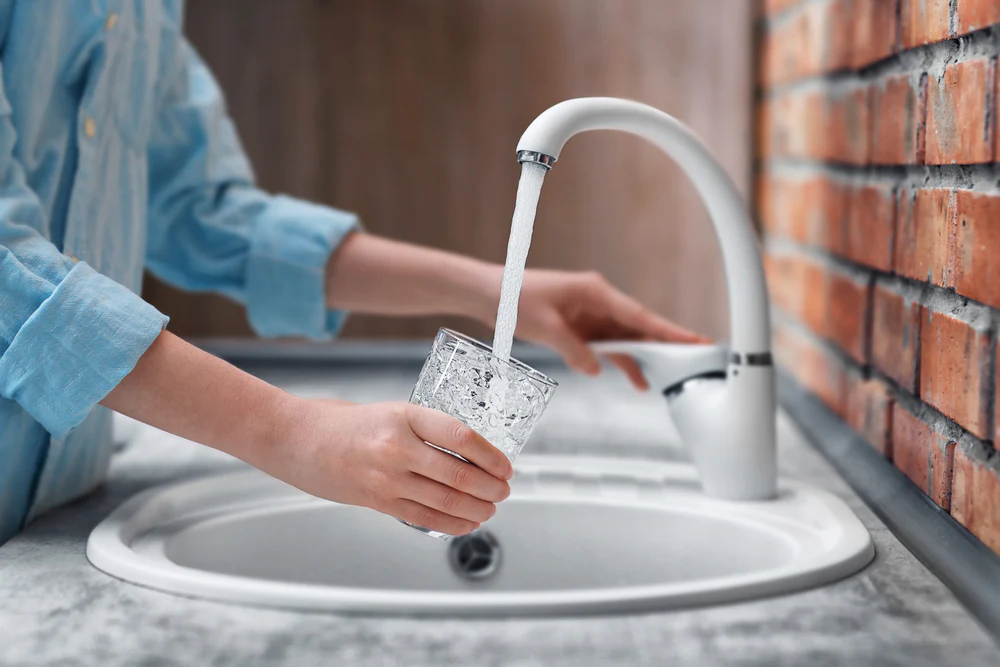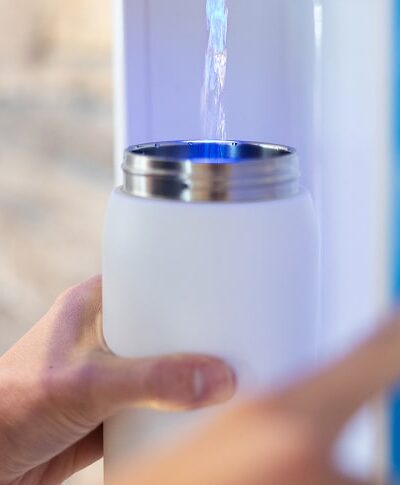It’s normal to have contaminants in your drinking water when you source it from the tap. Each city has its own recommended levels they follow, in addition to the guidelines set forth by the U.S. Environmental Protection Agency (EPA). However, just because tap water is deemed potable, it’s likely you’re drinking water that contains dirt, rust, chemicals, and other pollutants that leach from the pipes or originate from the groundwater and end up in what you drink.
Among the top contaminants in your drinking water are nitrates, bacteria and viruses, arsenic, fluoride, and lead. Learn how these make their way to your office tap water, the side effects they can cause, and the processes that are effective in filtering them out.
Nitrates
According to the Centers for Disease Control and Prevention (CDC), nitrates are one of the main contaminants in your drinking water that can cause harm to your health. They’re commonly found in chemical fertilizers, industrial waste, and septic systems. Improper well construction or location, overuse of fertilizers, and improper disposal of waste are responsible for toxic runoff. Although elevated levels of nitrate consumption is most harmful to infants, it can still have an adverse effect on adults as well.
Nitrate reduces the ability of red blood cells to carry oxygen. Per information provided by the Washington State Department of Health, adults who don’t produce enough stomach acids or who don’t have the enzyme that converts affected red blood cells back to normal are more vulnerable. It also poses a threat to women who are pregnant or trying to be pregnant.
Keep in mind, it’s likely your office tap water contains nitrates that are naturally produced at the source, just not at levels that typically cause harm.
Bacteria and Viruses
There’s also a chance for traces of bacteria and viruses to end up in your tap water. Those living in rural areas may be affected by animal waste that makes it way into the water source. There are also water-borne and water-transmitted viruses that may be present, such as hepatitis A and C, rotavirus, and norovirus. Currently, there’s not enough evidence to show whether the flu virus or the more recent coronavirus can be transmitted through the water.
Negative reactions to drinking tap water that contains bacteria are viruses include diarrhea, vomiting, fever, and abdominal cramping, according to data provided by PLOS Pathogens. Water treatment facilities routinely test for fecal coliforms and other bacteria in water supplies, but they don’t test for the presence of infection viruses because it’s not feasible or not possible to do so in a timely or cost-efficient manner.
Arsenic
Arsenic occurs naturally in the rocks and soil and is used for several purposes within the agriculture and industrial spaces. It’s a byproduct of mining, coal burning, and copper smelting. It also can be combined with other chemicals as pesticides and herbicides for crops. If you live in an area close to these types of facilities, there’s a chance your water may contain higher levels of this chemical.
Once arsenic is present in the groundwater, it remains for a long period of time and is removed slowly through precipitation. Drinking water that contains high levels of arsenic can lead to symptoms, such as headaches, fatigue, nausea, vomiting, and diarrhea.
Fluoride
Fluoride is another naturally occurring element found in the soil and groundwater. On its own, it’s not considered harmful to your health. Certain municipalities add fluoride to the water because research shows it can help prevent tooth decay. With the benefits come risks of other adverse health effects. According to the Association of Oral Medicine and Toxicology, these may include cardiovascular and neurological problems, as well as reproductive issues.
Additionally, per the EPA, fluoride levels above four parts per million in tap water could be hazardous. Most water plants regulate these levels and provide standard testing to confirm that it’s below the allotted limits.
Lead
Lead is one of the top contaminants that may be found in your drinking water. Old water systems and pipes can leach lead into the water as it makes its way to your tap. According to the EPA, household fixtures that date back to 1985 or before are likely constructed of lead. It’s expensive and timely to replace water systems, which is why there are usually delays in doing so.
Lead can accumulate in the body over time and reach harmful levels that can wreak havoc on your health. Although there’s been significant advances to reduce the level of lead found in tap water as per the Safe Drinking Water Act requirements, there’s still a chance you may be drinking out of a faucet that contains lead. The amount of corrosion that occurs depends on the acidity of water, types and amounts of minerals in the water, and how long the water stays in the pipes.
Removing Contaminants in Your Drinking Water
These are part of a short list of what may be found in your tap. City water facilities allow low levels of chemicals and contaminants in your drinking water, which affect people in different ways, depending on immune systems, age, and how much has accumulated in the body. When you only have tap water to rely on as your go-to source of water at work, it’s not necessarily the best for employees health-wise, and it may not taste great either.
The most effective filtration available is reverse osmosis. This process removes all dissolved particles from water by using a semi-permeable membrane. Its job is to effectively eliminate all tiny particles that may be present in your tap water. The drawback is that reverse osmosis works so effectively, it also filters out any healthy minerals found in the water as well.
Since the membrane can’t separate what gets filtered out and what remains, everything is removed, leaving you with purified water, but not the healthiest or best-tasting water. The difference with the FloWater filtration process is that advanced osmosis is only one of the seven filters in place. It removes all large and small particles, including pesticides, bacteria, viruses, chemicals, and other contaminants. Then, additional filters add in minerals and electrolytes to improve water quality and taste.
FloWater’s Advanced Filtration Process
FloWater’s filtration process in the water purifier system starts with sediment removal that gets rid of all dirt, rust, and dust found in the pipes and your water system that make its way into your tap water. The second carbon filter removes all smaller particles, such as chlorine and hydrogen sulfide, in addition to unpleasant odors and tastes. After tap water passes through these two filters, the advanced osmosis process eliminates any remaining particles and contaminants in your drinking water to purify it at a rate five times more efficient than anything else available.
Next up is the improvement phase, which is made up of three filters that add extra oxygen, minerals, and electrolytes back to the water. The fourth activated oxygen filter adds a third oxygen atom that naturally sanitizes the tanks and community water system. It also provides extra oxygen for the blood and muscles and helps to improve the taste.
The alkaline enhancement and electrolyte enhancement filters add trace minerals and magnesium, sodium, calcium, and potassium. Alkaline helps to neutralize acidity in the body and the latter gives the body electrolytes it needs to feel energized and hydrated. Finally, the coconut carbon finish removes any final odors or tiny particles and leaves the water with its unique, refreshing taste.
Enjoy Crisp, Filtered Water On-Demand
When making water available to your employees, it’s best to err on the side of safety with a water system that filters out all traces of pollutants and contaminants. It provides a more sustainable option than offering bottled water by eliminating the need for plastic waste. While using water from the tap may work fine for washing dishes and wiping down counters, giving people access to fresh, filtered water is best. It encourages people to drink more of it to stay hydrated and focused throughout the day.
The water dispensing system is already designed to minimize the spread of germs through its touchless technology and self-sanitization, perfect for what’s necessary for today’s workplaces. Our water refilling station is now also equipped with a foot pedal to refill water bottles and containers for a contact-free experience.
Furthermore, the quick freestanding water dispenser allows employees to fill up quickly and easily practice social distancing. It only takes nine seconds to fill a 24-oz. bottle. The dispensing area can fit any size of container, though. Since the system contains seven gallons of filtered water at all times, each person receives the same quality and optimal temperature of perfectly chilled water without worrying about having it run out or run warm.
Each city’s water source has its fair share of contaminants that make their way to your office tap water. They’re measured at levels that are deemed safe for consumption. However, to ensure these are fully removed and you’re drinking the freshest, healthiest water available, make FloWater available for your employees and guests.
Sources:
- https://www.cdc.gov/healthywater/drinking/private/wells/disease/nitrate.html
- https://www.doh.wa.gov/CommunityandEnvironment/DrinkingWater/Contaminants/Nitrate
- https://www.ncbi.nlm.nih.gov/pmc/articles/PMC4482390/
- https://www.cdc.gov/healthywater/drinking/private/wells/disease/arsenic.html
- https://www.medicalnewstoday.com/articles/154164#risks
- https://www.cdc.gov/nceh/lead/prevention/sources/water.htm




